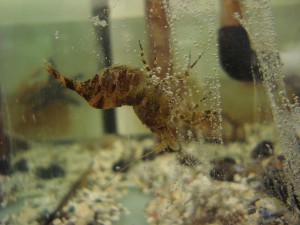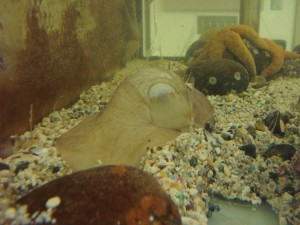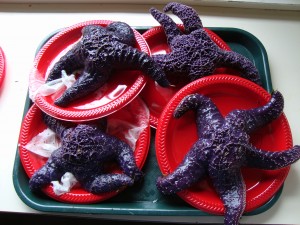To the approximately 0.00014% of the population that owns a tank capable of maintaining such creatures, I feel I should warn that the moon snail, or likely any large, predatory gastropod, is a monumental homewrecker. In the clean, crisp, 10-degrees-Celsius salt water of the Thompson room 215 tank, the anemones, mussels, and gunnels were living in peace and tranquility, nestled in their smooth faux gravel and perfect salinity. And then came the moon snails. After just a few minutes Jaba the Moon Snail, Gus the Gastropod, and T-Swift the Tank Trasher had carved snail-trails through the neat gravel and displaced every rock in the tank. Hours later the mucus from their slimy laps around their glass corral began to collect in bubbly strands extending toward the surface of the water like ropes of bubbles. At one point a small shrimp was hanging upside down with his legs all wrapped in a mucus rope, a most panicked site. Eventually he wriggled free of his colloid trappings, but it will take a lot of years of therapy to relieve that fear of heights.

A shrimp caught upside-down in a mucus rope, residue from the gelatinous gallivanting of the moon snail terror trifecta.
An anemone also fell victim to the road rage of these massive mollusks, getting completely run over by the giant slimy foot of Jaba the Moon Snail and half-buried in displaced gravel. And the rest of the tank was left in general chaos and disarray. Ultimately, we decided to return the three moon snails to the beach where we found them and relieve our tank of their terror.

Jaba the Moon Snail on a tour of terror.
The snails were collected from Alkai Beach in Seattle where Stephen and I were conducting a sea star survey. As a popular family beach destination, Alkai was littered with children who were first curious as to what we were doing with buckets of sea stars and then excited to help our cause. One such little girl seemed particularly bent on ensuring my efficiency, following closely behind me with a snooty chorus of, “you missed one.” Needless to say, I was actually selecting certain color morphs for collection and ignoring others, but she just figured she had an eye for echinoderms that I did not.
For sea star surveys, such as the one at Alkai Beach, we collect sea stars (with a permit) and pack them carefully into buckets on plastic plates. After we have recorded all their details back at the lab, the stars need to be returned to their proper locations.

Pisaster ochraceus plated for collection and analysis.
Unfortunately, by the time we have finished with them the tide has come back in and their intertidal zone is covered by water. This led to one particularly exciting afternoon at Titlow Beach last week. We returned to Titlow with 115 sea stars to be returned to the intertidal and found that the water had come in about 50 meters and was certainly not of wade-able depth. Instead, Stephen insisted that I swim our five-legged fold back to the proper area. Seeing as we had no where else to house them overnight, and I am aware of the commitment of diligence and sacrifice I have made to science, I agreed. With a 5-gallon bucket of sea stars in each hand I did my best to float and kick my way out to sea. Although the Tacoma Locals watching seemed a bit surprised at my determined dip in South Sound, this worked fine. Until I had to get the sea stars out of the buckets. I was sprinkling sea stars like I was Cinderella and they were corn, hovering like a Disney princess. And then the buckets began filling with water.
I won’t bother explaining why I was unable to empty the buckets, but trying to swim with two full 5-gallon buckets of water was quite the struggle. I think it was Stephen’s reassurance that he would not be jumping in to save me and the slight assist of the tide still coming in that allowed my leaded trudge of a swim-stroke to actually propel me back to shore. I survived, so I suppose the endeavor was a success.
Our next set of adventures should take Stephen and I to the outer coast of Washington to visit some sites along the Pacific Coast, beginning in the first week of July.
My birthday is this Sunday and my hair is currently hot-hot pink.
